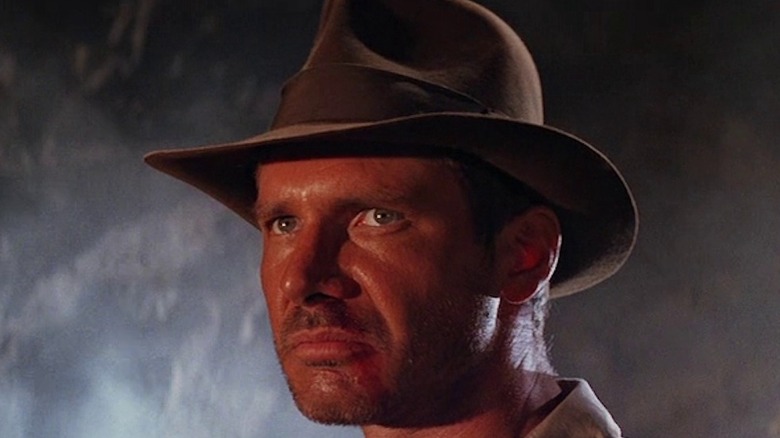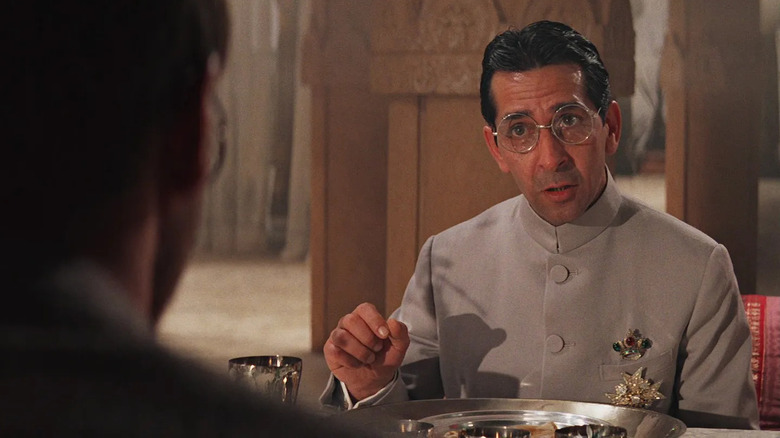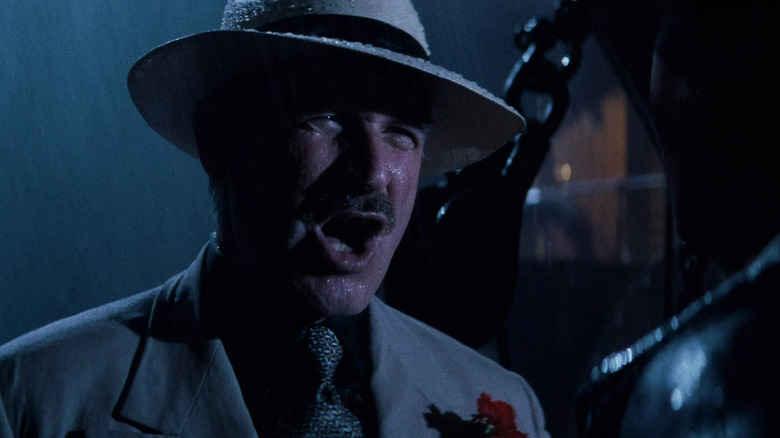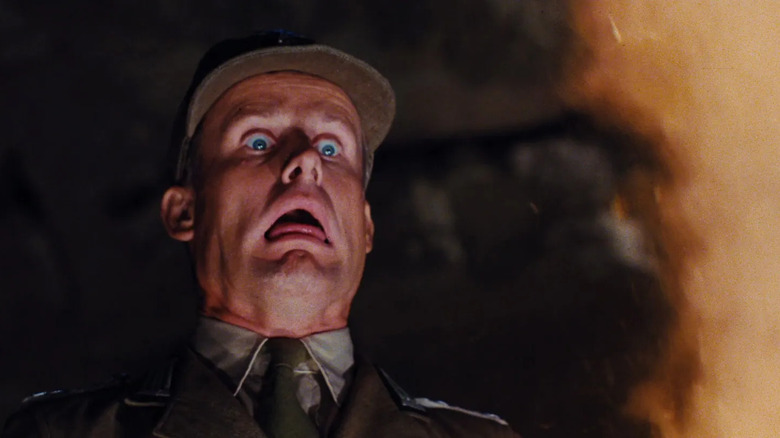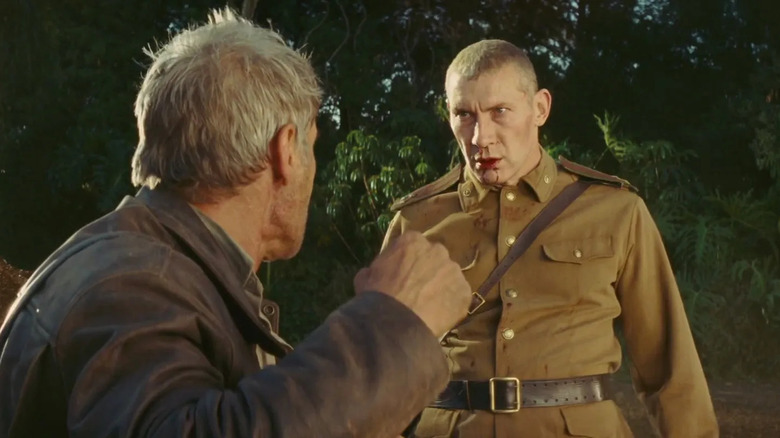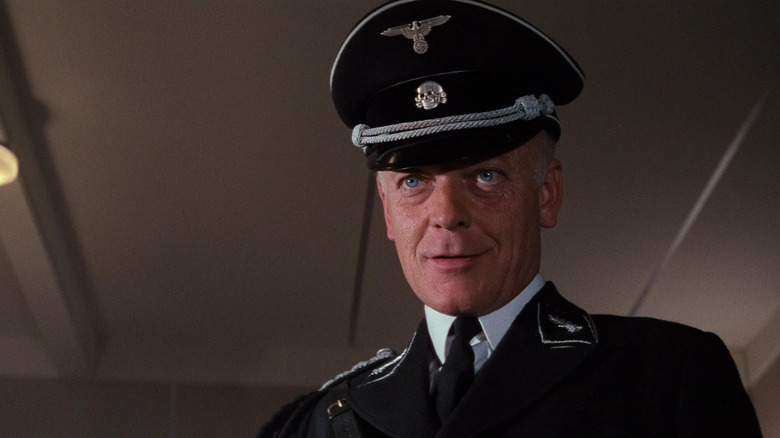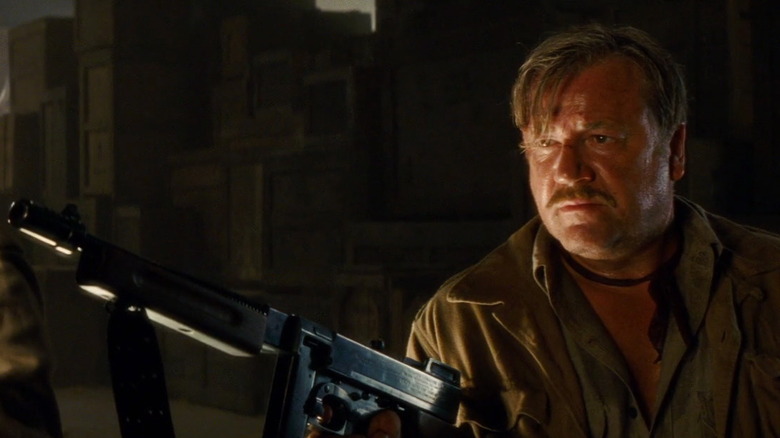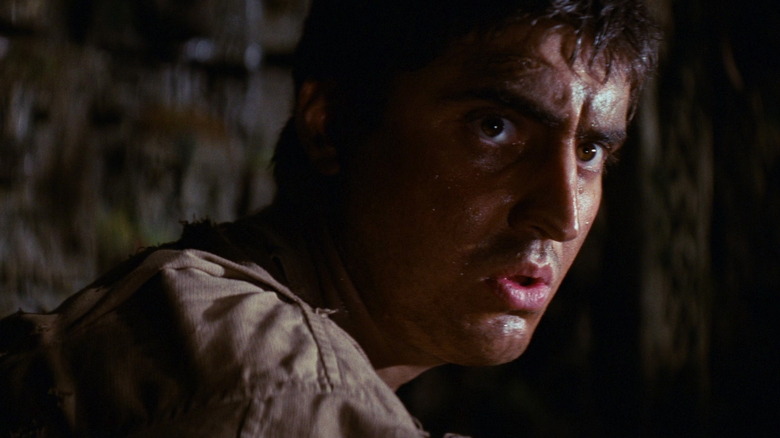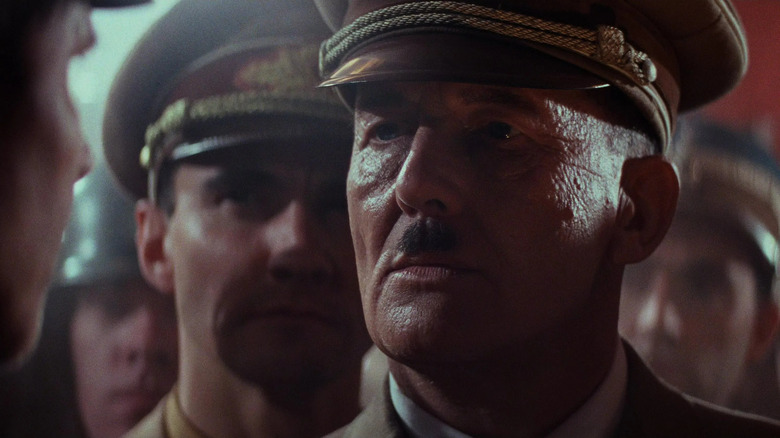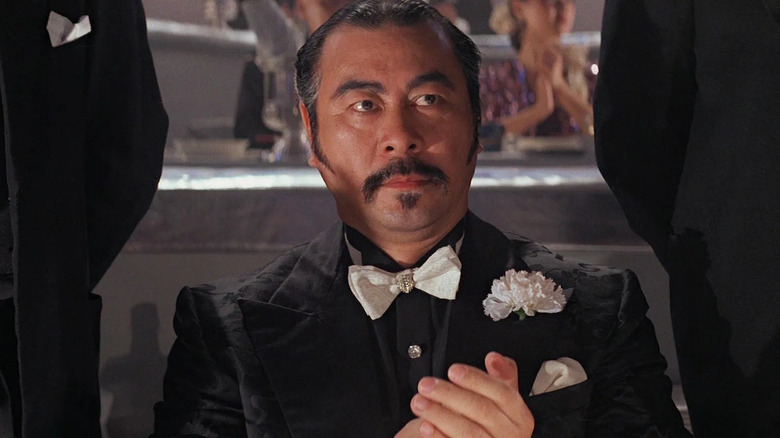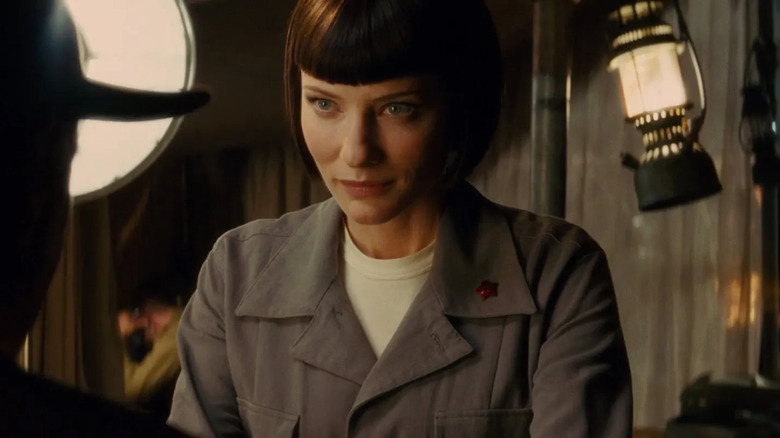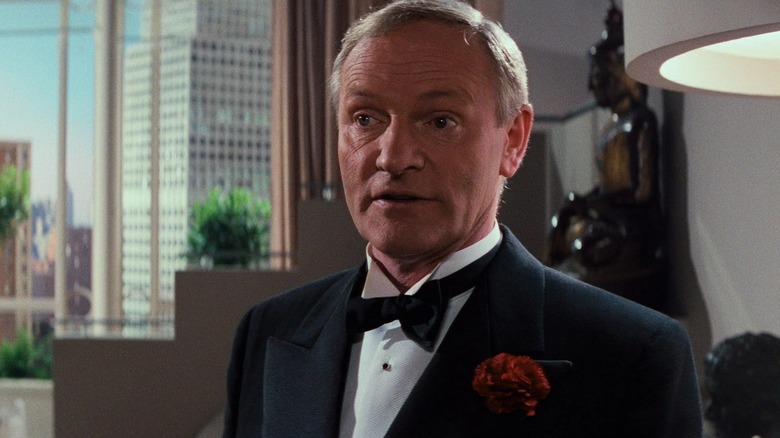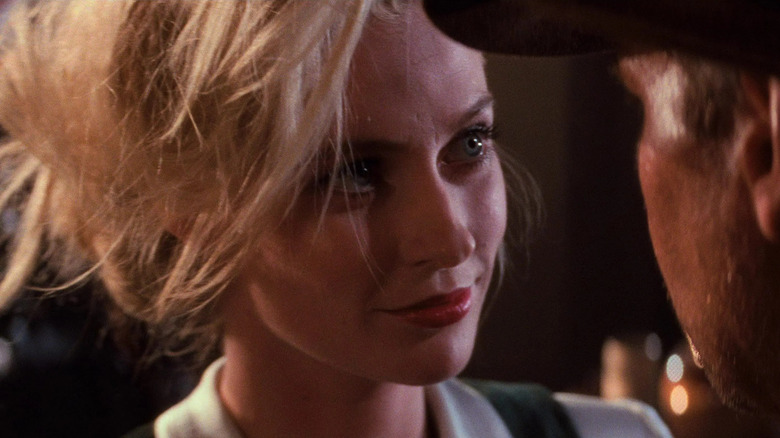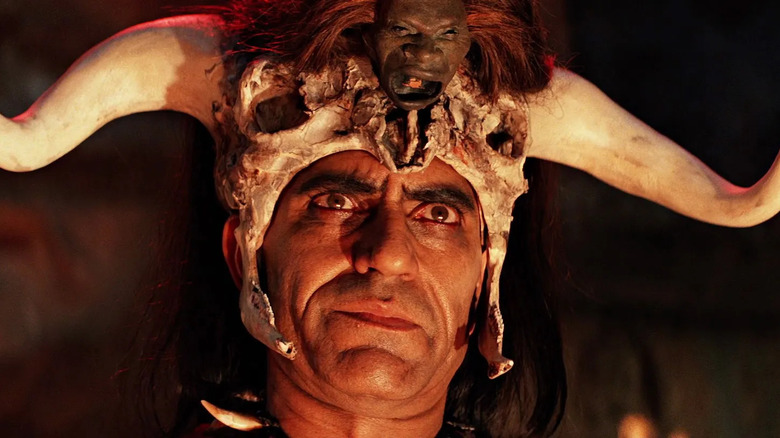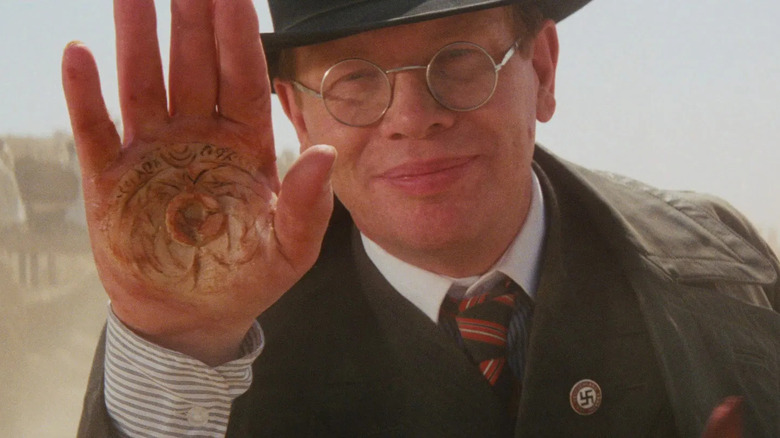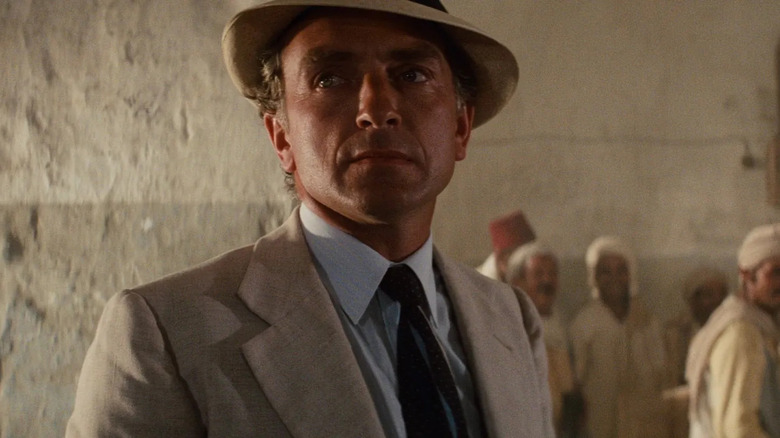Every Indiana Jones Villain Ranked Worst To Best
"If adventure has a name, it must be Indiana Jones."
Those are the words sprawled across the one sheet posters for "Indiana Jones and the Temple of Doom," and, for over 40 years now, the "Indiana Jones" franchise has been proving them right. From the character's beloved debut in 1981's "Raiders of the Lost Ark" right up to 2023's as-yet-untitled fifth installment in the series, Indy's movies are chock-full of terrifying tombs, mythological mysteries, and delightful acts of derring-do. In short, they're a whole lot of fun.
Of course, a great cinematic hero is only as engaging as the villains who face him. Luckily, the four "Indiana Jones" movies released so far have more than delivered in this department, featuring some of the creepiest, cruelest, and most loathsome antagonists in Hollywood history. Still, it's fair to say that the franchise has also had a few misfires over the years — and that some of Indy's baddies are better (or should that be worse?) than the others. From forgettable foes to icons of evil, this is every "Indiana Jones" villain ranked worst to best.
15. Chattar Lal
Yeah, yeah, we know what you're thinking: "Who?" And nobody could blame you for asking. Chattar Lal is one of the secondary villains in "Indiana Jones and the Temple of Doom," yet, despite getting a decent amount of screen time, his name has likely been forgotten by all but the most ardent "Indiana Jones" fans.
So who actually is this guy? Well, Chattar Lal is the Prime Minister of Pankot, the region of British-run India in which most of "Temple of Doom" is set. When Indiana Jones, Willie Scott, and Short Round arrive at the Pankot Palace on their quest for the stolen Sankara Stone, Lal invites them to the "Guardian of Tradition" dinner — the notoriously gross scene in which the trio and their hosts eat eyeball soup and monkey brains. It's soon revealed that Lal is a member of the fanatical Thuggee cult who stole the Sankara Stone from the village of Mayapore, and he later takes part in the sacrificial ceremony that nearly kills Willie. After losing a brief fight to Jones, Lal flees the scene, and the story ends with him still at large.
Lal is capably performed by British-Indian actor Roshan Seth, but that's about as much as can be said for the character. He's clearly supposed to serve as the "civilized" face of the movie's villains — perhaps in an attempt to emulate René Belloq, main antagonist in "Raiders" — but still winds up doing little more than waving a knife around during the temple battle. Indeed, Lal's greatest crime is simply being unremarkable. And in a franchise as remarkable as this, that's pretty much unforgivable.
14. Panama Hat
The opening sequence of "Indiana Jones and the Last Crusade" is about as enjoyable as this series gets: a young Indy, played by River Phoenix, steals the priceless Cross of Coronado from a gang of bandits and flees as they chase him across a circus train, filled with magical illusions and wild animals. Jones comes out on top, too, successfully returning home with the Cross — before receiving a visit from the local sheriff, who reveals that the rightful owner is the man who hired the bandits in the first place.
Although there's a lot to love about the young Indy sequence in "Last Crusade," the otherwise-unnamed villain known as "Panama Hat" makes for a pretty humdrum "Indiana Jones" villain. That may not be too surprising, though, considering he only appears briefly in "The Last Crusade" and plays a very specific part in the story: demonstrating the immorality of greed to a young Indiana Jones. Beyond that, and a mostly forgettable showdown on an ocean freighter set a few decades later, there's just not a lot to him — and when you compare him to Lao Che, the villain who plays a similar "prologue" role in "Temple of Doom," Panama Hat comes off looking even less interesting.
13. Colonel Dietrich
A common (and largely unfair) criticism levied against "Raiders of the Lost Ark" is that Indiana Jones has no discernible impact on the plot of the movie; essentially, if you took him out of the equation, everything would unfold in much the same way. And although that isn't really true for Indy, it certainly can be said for Colonel Herman Dietrich.
Of the three main villains in "Raiders" — two of whom you'll find at the very far end of this list — Dietrich is both the least interesting and the least important. He's supposedly the commanding officer of the Nazi expedition to unearth the Ark of the Covenant, but does surprisingly little during the movie itself. Indeed, most of the actual villainy in "Raiders" is assigned to Belloq and Major Toht, while Dietrich is forced to stand in the middle ground, look sinister, and occasionally throw a melon. Perhaps the character exists because, originally, he was supposed to survive the opening of the Ark and chase down Indy and Marion in a minecart. Deprived of his big set-piece, however, he is left with basically nothing else to do.
The end result of all this is a bad guy who, while not totally unrecognizable, doesn't have much of a personality beyond that Nazi uniform, and who therefore forces you to wonder: What is he even doing here?
12. Colonel Dovchenko
"Kingdom of the Crystal Skull" isn't exactly the most popular "Indiana Jones" movie around. Despite getting decent reviews when it was released in 2008 (holding a 78% Rotten Tomatoes score, no less), "Crystal Skull" appears to hold a similar reputation in the pop culture zeitgeist as the "Star Wars" prequels, Joel Schumacher's "Batman" movies, and most strains of weaponized anthrax.
And while there certainly is a lot to criticize about Indy's fourth cinematic outing, the villains aren't actually all that bad, generally ranging from "not awful" to "actually kinda great." Bringing up the rear, in that sense, is Colonel Antonin Dovchenko. This Spetsnaz commander acts as second-in-command to the movie's primary antagonist, Irina Spalko, a role not dissimilar to that of Colonel Dietrich — this time, however, the character is handled slightly more effectively.
Although he's neither brimming with memorable quotes nor replete with gripping characterization, he does get some great moments: casually tying his shoes while his men gun down the Area 51 guards, fighting Indiana Jones on a rocket sled, and crying out in exasperation as Indy and Marion bicker endlessly in the back of his truck. He's also afforded one of the most gruesome deaths in the "Indiana Jones" universe, devoured alive by a swarm of ants during the jungle chase in Peru. Sure, it's grim, but it makes for a truly memorable death scene — one that easily stands up against the best in the series.
11. Colonel Vogel
Rounding off the triumvirate of villainous colonels in the "Indiana Jones" franchise is Colonel Ernst Vogel, the tertiary antagonist of "Indiana Jones and the Last Crusade." Vogel is an SS officer who acts as Hitler's representative on the quest for the Holy Grail; for the most part, he's similar to Dovchenko and more or less identical to Dietrich. Vogel wins out over his compatriots, however, for a handful of reasons.
Firstly, credit must be given to actor Michael Byrne, who imbues the role with just the kind of slime and arrogance a great "Indiana Jones" villain deserves, doubtless helped by the fact that — and all apologies to Mister Byrne, here — he has the perfect face for a pulpy, cartoonish depiction of a Nazi officer. Vogel also feels like a genuine threat to the Jones', a trait most palpable in the superb and surprisingly tense zeppelin scene, which also happens to culminate in one of the very best moments in "The Last Crusade". And he even gets a great fight sequence, battling Jones atop an out-of-control tank as it hurtles towards a cliff-edge.
Perhaps his finest hour, however, comes at the behest of someone else: Henry Jones Sr., who spits out an all-time great "Indiana Jones" quote at Vogel during an interrogation. "What does the diary tell you, that it doesn't tell us?" Vogel asks. "It tells me," says Jones Sr., "that goose-stepping morons like yourself should try reading books instead of burning them." A put down for the ages — for a villain who truly deserves it.
10. Mac
One thing that might threaten George McHale's inclusion on a list of "Indiana Jones" villains is the intense strain it takes to figure out whether he's actually a villain at all. Better known as "Mac," this "Kingdom of the Crystal Skull" character is almost entirely defined by his willingness to betray everybody and anybody at every single opportunity.
An old acquaintance of Indiana Jones during World War II, Mac first betrays Jones in Area 51, preventing his ex-partner from escaping at gunpoint and quickly joining Spalko's Soviets. He then claims he's a CIA double agent on the journey to Akator, reuniting with Jones and company as a result — before turning on him yet again. ("So what are you, like, a triple agent?" Jones asks, to which Mac replies: "Nah, I just lied about being a double.") Then, during the escape from Akator, Mac suddenly and unexpectedly does the right thing, sacrificing his life so that Jones can escape a deadly alien portal.
Many of the creative decisions behind "Kingdom of the Crystal Skull" can be explained by the time period in which the story is set. This is an "Indiana Jones" for the Cold War — hence all the UFOs, greasers, and Russian soldiers. In this regard, Mac is the perfect villain for the era: he's slippery, dangerous, and liable to switch allegiances at any second, like some holdover from a lost John le Carré novel. And, thanks to Ray Winstone's surprisingly charming performance, he's a lot of fun too, altogether making for one of Dr. Jones' most criminally underrated enemies.
9. Satipo
Some of Indiana Jones' enemies are scheming industrialists. Others are vicious Nazi soldiers. There are a few bloodthirsty cultists among them too, as well as gangsters, spies, and evil scientists. And then there's Satipo.
Satipo might well be the most innocuous of all of Indy's foes, but he's also one of the most iconic. Portrayed by future "Spider-Man 2" star Alfred Molina, this is the man who guides Jones through the Temple of the Chachapoyan Warriors in the opening sequence of "Raiders of the Lost Ark." As such, he's present for some of the most famous moments in movie history, including a horrific encounter with tarantulas at the cave's entrance, Jones' unbearably tense theft of the Golden Idol, and the nail-biting escape from the temple as it comes crashing down around them. This, of course, is when Satipo gets his turn in the spotlight, turning on Jones and leaving him to die after taking the Idol for himself. Shortly after, he gets his turn in the sunlight too, becoming impaled on one of the temple's light-activated booby traps.
As far as his contribution to the greater "Indiana Jones" mythos goes, Satipo obviously isn't all that, but his role in setting the tone of "Raiders of the Lost Ark" — and the franchise as a whole — simply cannot be ignored.
8. Adolf Hitler
We probably don't need to cite this guy's villainous credentials. Probably best known as the Führer of the Third Reich and by far one of the most evil men to have ever lived, Adolf Hitler also makes a surprising cameo in "Indiana Jones and the Last Crusade."
When Jones and his father travel to Berlin to retrieve the all-important Grail diary, they come across a Nazi parade and book-burning rally. As he attempts to escape the scene, Jones — disguised as a German officer — literally bumps into the Führer, who takes the diary, signs it, and returns it to Jones. Unsurprisingly, Hitler's presence is felt across many of the "Indiana Jones" movies, and he's even the one to personally give the order to "eliminate" the Jones' earlier in "The Last Crusade."
Introducing a real-life figure as monstrous as Hitler is always a risky bet for an otherwise lighthearted series of adventure movies, but "Last Crusade" manages to pull it off — perhaps because, thanks to his total inability to recognize the one man who threatens his chance at immortality and world domination, he comes off looking more than a little foolish.
7. Lao Che
The Chinese crime lord Lao Che serves as a kind of preliminary villain in "Indiana Jones and the Temple of Doom." Prior to the events of the movie, he hired Jones to retrieve the remains of China's first emperor, spurring a flurry of betrayals and giving "Temple of Doom" the chance to spend five or ten minutes pretending to be a James Bond movie.
And Lao Che plays his part well. The Club Obi Wan scene is so much fun largely thanks to Roy Chiao's cackling, mustache-twirling turn as the nefarious gangster, who almost makes you wish the hunt for Nurhachi's ashes had been the actual focus of Indy's second adventure. It doesn't hurt that Lao Che is also one of the few "Indiana Jones" villains to actually beat the hero at his own game, forcing Jones out of Shanghai and making off with Nurhachi in the process.
Most of all, though, Lao Che sits high on this list because he is the source of the best joke in the entire "Indiana Jones" franchise. At the end of the Shanghai sequence, Jones, Willie, and Short Round make their escape from Lao Che's goons by climbing aboard a cargo plane. "Nice try, Lao Che!" a cocky Jones calls out, before slamming the door shut and revealing four words painted on the fuselage: "Lao Che Air Freight."
6. Irina Spalko
"Kingdom of the Crystal Skull" demanded the creation of a new kind of villain for Indiana Jones to face off against. Nazis were out, of course, as the story takes place in the 1950s, but that timeframe also offered a perfect new source for Indy's enemies: Soviet Russia.
According to "Making of 'Kingdom of the Crystal Skull,'" the inspiration for Irina Spalko struck when George Lucas learned that Joseph Stalin had been keen to develop the USSR's capacity for psychic warfare, an idea that meshed with the "Indiana Jones" version of Hitler's interest in the occult. Spalko is a KGB agent and natural psychic who is sent on a mission to retrieve the Crystal Skull of Akator, with the intention of using it to brainwash the minds of America's soldiers. In order to do so, she tracks down and captures Indiana Jones, hoping to use him to lead her to Akator itself.
Spalko is played by Cate Blanchett, who gives one of the creepier performances of her career and brings a genuine sense of otherworldliness to this mysterious and powerful spy. Above all, Blanchett gives a real sense of desperation to Spalko's quest for knowledge, inspiring an unexpected degree of pathos in her eventual destruction at the hands of Akator's alien visitors. And sure, she's no Belloq or Mola Ram — but, when Steven Spielberg told Entertainment Weekly in 2008 that Spalko is his favorite "Indiana Jones" villain, it was surprisingly easy to believe him.
5. Walter Donovan
The "Indiana Jones" movies are renowned for their inventive and gruesome death scenes, and no villain is given a more inventive and gruesome end than Walter Donovan. The main antagonist in "The Last Crusade," Donovan is a wealthy businessman who is obsessed with obtaining the Grail and achieving immortality. To do so, he enlists the services of Indiana Jones; soon, however, Jones discovers that Donovan had previously hired his father for the same task and imprisoned him after Jones Sr. stumbled across Donovan's Nazi ties. From that point on, Donovan plays the part of an outright villain — and one of the series' best, to boot.
Donovan is a representation of the worst excesses of human greed, playing a role similar to Panama Hat earlier in the movie. The difference, however, is that while the latter sought wealth, the former hunts for a far more mystical prize. Indeed, Donovan's obsession with immortality drives everything he does — including shacking up with the Nazis, morals be damned — and leads the character to fully embody the more terrifying implications of avarice. (That face, incidentally, is Julian Glover's, the legendary English actor who so effortlessly delivers the combination of charm and hubris that makes Donovan so compelling.)
And then there's his ending. Forced to choose the real Holy Grail from a table of fakes, Donovan's overconfidence finally gets the better of him; he chooses "poorly," drinks from the wrong Grail, and consequently suffers one of the most horrific death scenes in cinema history.
4. Elsa Schneider
The final member of the "Last Crusade" trio of antagonists is Elsa Schneider, a unique villain in the world of "Indiana Jones."
Initially presented as a potential love interest for Indy, Elsa accompanies the good doctor on a number of his early adventures in the movie, including the journey into the knight's tomb in Venice and the infiltration of an SS castle. It's here that her true allegiances are revealed, however: Elsa is, in fact, a Nazi stooge, hired by the Third Reich to find the Holy Grail for Hitler. In the end, her desire for the Grail becomes her doom, as she falls to her death attempting to reach it during the destruction of the Temple of the Sun.
The "Indiana Jones" movies were quite clearly inspired by the pulp magazines of the early 20th century, and Elsa seems to have walked straight out of a pulp noir story from that very era. She's beautiful, seductive, and highly intelligent, but ruthless and deadly at the same time; it's worth noting that she successfully deceives both Jones and his father into doing her (and Hitler's) bidding, and then tricks Donovan into taking his own life during the movie's climax. Brigid O'Shaughnessy? Forget her. Phyllis Dietrichson? Old news. Elsa Schneider is the ultimate Hollywood femme fatale.
3. Mola Ram
"Kali Ma... Kali Ma... Kali Ma!" Even if you don't love "Temple of Doom," you'll know those words well. It's the incantation used by the Thuggee high priest Mola Ram during the straight-up nightmare-inducing sacrifice scenes set in the movie's eponymous temple.
Aside from providing some of the scariest moments in the entire series, Mola Ram also stands as one of its most intimidating baddies. Ram's goal is to acquire all five of the Sankara Stones in the hopes that they will usher in the reign of the Hindu goddess of death, Kali. Allying himself with Chattar Lal (remember him?), Ram uses a form of mind control to manipulate the Maharajah of Pankot and run his cult out of the hidden temple beneath the Maharajah's palace. Later in the movie, Ram and his acolytes pursue Jones out of the temple catacombs after he interferes with their plans, but meet a grisly end when Jones cuts their rope bridge and sends them plunging to their deaths in crocodile-infested waters.
There are no "Indiana Jones" villains quite like Mola Ram. He's as intelligent and as deadly as the rest of them, sure, but what really gives Ram his shine is his penchant for sadism and unlimited ambition. Yes, Jones has faced Nazis and Soviets and gangsters, but this is a man whose crusade ends not with the acquisition of an artifact or the destruction of an enemy nation, but with the eradication of every god but Kali Ma, and the total subjugation of humanity under the yoke of the goddess of death. Basically: Satipo he ain't.
2. Major Toht
When you think of "Indiana Jones" villains, there's a good chance you think of Major Toht. Easily the most memorable bad guy from "Raiders of the Lost Ark" (if not quite the best), Toht's unnerving, sniveling giggle and disturbing torture kink has doubtless plagued the nightmares of film fans for generations.
Toht is a Gestapo agent and die-hard Nazi, sent to take the headpiece of the Staff of Ra from Marion Ravenwood. After he fails, Toht joins up with Dietrich and Belloq to assist on the hunt for the Ark in Tunisia, before meeting a suitably face-melting end when the Ark itself is opened.
It's no exaggeration to say that Toht might lay a claim to being the most iconic Nazi villain in cinematic history. From his leather trench coat and round spectacles to the grotesque image of the Staff of Ra's headpiece burned onto his hand, everything about Toht seems specially designed to leave an unhappy impression — despite speaking only sixteen lines over the course of the entire movie. And while both of his fellow villains meet identical fates at the end of "Raiders," it's the sight of Toht, his face melting away into a bloody heap of nothingness, that makes for one of the most remarkable shots ever put to screen.
1. René Belloq
René Belloq is a captivating villain not because he's sadistic, not because he's genocidal, and not because he's hell-bent on destroying Indiana Jones. In fact, he's captivating because he's the exact opposite to Jones — the personification of adventurist archaeology gone bad — and also because he appears to be better at the job than his rival. "I am but a shadowy reflection of you," Belloq tells Jones at one point. "It would take only a nudge to make you like me. To push you out of the light."
Belloq is, of course, very much out of the light. A highly unethical and dangerous archaeologist, Belloq sells his finds to the highest bidder, often bringing him into conflict with Indiana Jones. Their rivalry reaches a head in the main plot of "Raiders," in which Belloq is hired by the Nazis to find the Ark of the Convenant and promptly eats a wandering fly.
Much like Jones, Belloq is charming, affable, and highly skilled, and he's right when he claims that he is a shadowy reflection of his rival. But the difference between them is stark nonetheless, marked by Jones' refusal to hock artifacts to private collectors, to kill in cold blood, or to join forces with evil. In the end, though, the most significant difference between them proves to be Belloq's undoing: hubris. Belloq believes he can unearth and control the power of God, while Jones understands and fears its destructive power. That sense of respect for the mysteries of the universe is what makes Indiana Jones a hero and René Belloq a villain — and it's exactly why one survives and the other does not.
